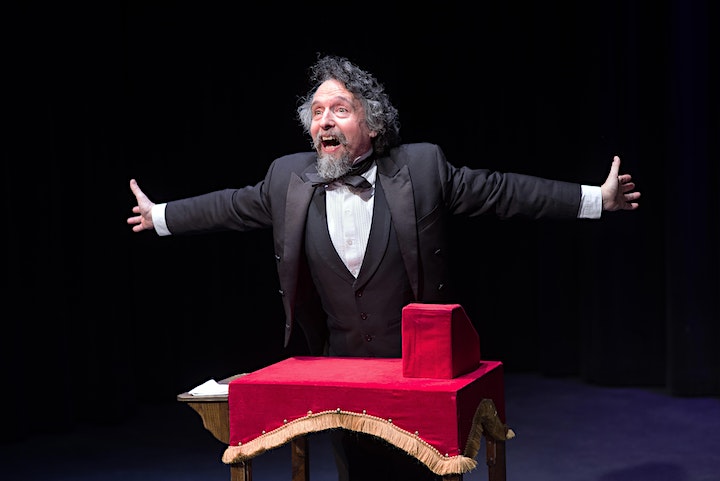No Humbug Here: John D. Huston Returns with ‘A Christmas Carol’

After 180 years, you’d think A Christmas Carol would be as dead as a door-nail.
First published in 1843, A Christmas Carol is one of Charles Dickens’ best-known literary works. The story follows Ebenezer Scrooge as he’s visited by a series of ghosts and is transformed from a misanthropic miser into a gentler, more generous person. A Christmas Carol, which has remained in print for nearly two centuries, has also enjoyed popularity through stage and film adaptations.
John D. Huston’s one-man adaptation, now in its 32nd season, will be raising spirits in Kingston this Sunday, December 17th, at the Tett Centre. Last week, I met with Huston over Zoom to discuss the past, present, and future of A Christmas Carol.
This interview has been edited for clarity and length.
What compels Huston to keep performing A Christmas Carol after three decades? For that matter, what has kept audiences interested in this story for 180 years? “The draw of the story is—I say this all the time—it’s the redemptive power of the story. It’s a story infused with an enormous amount of hope and optimism.”
While the pandemic briefly dampened attendance at Huston’s shows, things are looking up again. “I’m currently enjoying the biggests crowds since COVID. This is the best year I’ve had by far since 2020. And I don’t think it’s just that people are saying, ‘Oh, COVID’s over,’ even though it’s not. We’re in a really pessimistic period right now… So there’s the message of the story, and there is that comfortable familiarity.”
Naturally, Huston and I spend some time discussing our favourite film adaptations of A Christmas Carol. “When I was a kid, the only version that you could ever find on television was the 1951 Alastair Sim version, which is called Scrooge in Britain and A Christmas Carol in North America. So that was the only one I saw for years. And then sometime in about 1988, these earlier versions started showing up. Maybe the copyright expired, I don’t know what happened. All of a sudden, the [1935] version with Seymour Hicks was on television.”
Although Sim’s portrayal of Scrooge is closest to his heart, Huston has another favourite: “The other version that I tend to watch every year now, and have since it first came out 31 years ago, is the Muppet version. Which is so charming—Michael Caine is really the only other good Scrooge out there. I’ve seen all of these others—I don’t know how many versions of this story—on film, and animated, and most of them just don’t get it.”
Over time, adaptations of A Christmas Carol have shifted to suit public sensibilities. For Victorian readers, Scrooge’s miserly disposition could be taken at face value: “In the book, Dickens says, you know, he’s Scrooge, he was who he was, and we’re never told why [he’s hard-hearted]… It’s just the way he is. And that is just how they saw people back then.” Newer versions of the story tend to give Scrooge more backstory. “It’s interesting, watching the contemporary takes on the story… We have to give this an explanation.”
As a solo performer, Huston—dressed as Dickens—narrates the story, and he also plays every character. “Scrooge is in every scene. If he doesn’t directly speak, we’ll at least see his reaction to everything. He has the most interesting dramatic journey, at least the most complete one. But the supporting characters are in many ways more fun, because they have to be more concentrated. Dickens has to work harder to make them memorable. And that means the actor gets to really play with that. Sharply defined, memorable little characters only on maybe for one scene, but the audience will remember them afterwards, because they have to do something really extraordinary, or they get to say a really great line. Like Tiny Tim, who only says basically one thing, but it’s the line: ‘God bless us, every one!’ That’s all he gets to say, but it’s the line, next to, ‘Bah! Humbug!’”
Every year, Huston looks forward to getting into A Christmas Carol’s characters again. “Each of them is very real to me, what they look like—if I passed them on the street, I’d know who they were. Sometimes it’s no more than half a dozen words for each character. But again, that’s the great thing about Dickens as a writer. He does give you a great half dozen words.”
John D. Huston’s ‘A Christmas Carol’ plays in Kingston at the Tett Centre at 1pm and 4pm on December 17th, 2023. Tickets and more information can be found here.